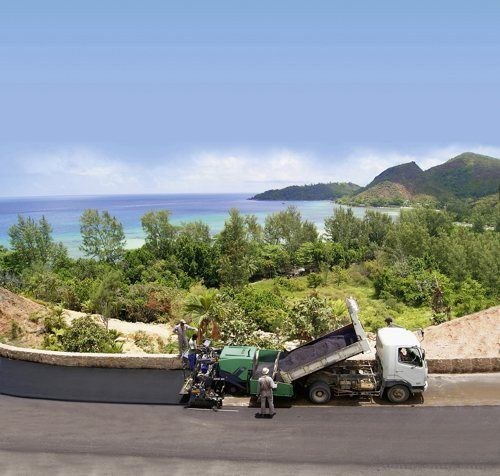The challenges in completing a major road construction project in Praslin, in the Seychelles
Improvisation is called for when building roads on the Seychelles. Challenges include steep gradients and hairpin bends in tropical conditions. Praslin, the second-largest of the Seychelles islands with roughly 6,500 inhabitants, is a tropical paradise of white sandy beaches, dense jungle and crystal clear seas.
Tourism is the island’s main source of income – and luxury tourism at that. A road had to be diverted for a new development project comprising the construction of a five-star hotel and property, creating jobs for around 400 people. This road would have obstructed the residents’ access to the sea.
Sey-Afrique Exporters, which is headquartered in Pinetown in South Africa, won the contract for construction of the new, roughly 1.5km stretch of road. The company chose a Vögele paver for the construction work.
Powerful and manoeuvrable
Conditions were not exactly simple. Temperatures between 35 and 40°C with relative humidity of over 90 per cent made this a physically gruelling job. To make matters worse, the topography was tricky with gradients of more than 20 per cent and tight hairpin bends. In short, the job called for a paver that was both powerful and highly manoeuvrable.
The Vögele Super 800 proved ideal for this job: the small paver handles pave widths from 0.5m to 3.2m. Its asymmetrical material hopper allows to work close to the edges, even in tight bends. A 45kW Deutz engine is installed for reliable power output and rapid progress: the machine can pave at speeds up to 60m/min.
Kerb served as a reference Obtaining asphalt was no easy matter on an island 12km long and 5km wide. Sey-Afrique Exporters had to revive an ancient mobile asphalt mixing plant in order to prepare bitumen-coated material. Although the mix did not meet the standard asphalt specifications, the Super 800 was nevertheless able to produce good results with it. Combined with an AB 200 Extending Screed in TV version, the paver placed two asphalt layers on a roughly consolidated base. The first one, a level-regulating layer between 3 and 12cm thick, was paved to equalize considerable unevenness. A layer of such strongly varying thickness is unusual, but the paver made light work of the task.
The existing kerb served as a reference. Then a 5cm wearing course followed. Around 80 tonnes of mix were paved every day for the roadway, which varied in width between 7.5m and 10.5m.
Easy operation
Helmut Bethge from Wirtgen South Africa trained and supervised the paving team throughout the job. Thanks to the paver’s easy operation and the professional support provided, the team were able to work successfully even in these trying conditions.
Bethge reports that it did not take long to instruct the men.
“Although most of them had never laid hands on a paver before, they were very soon able to operate it on their own,” said Bethge.





















